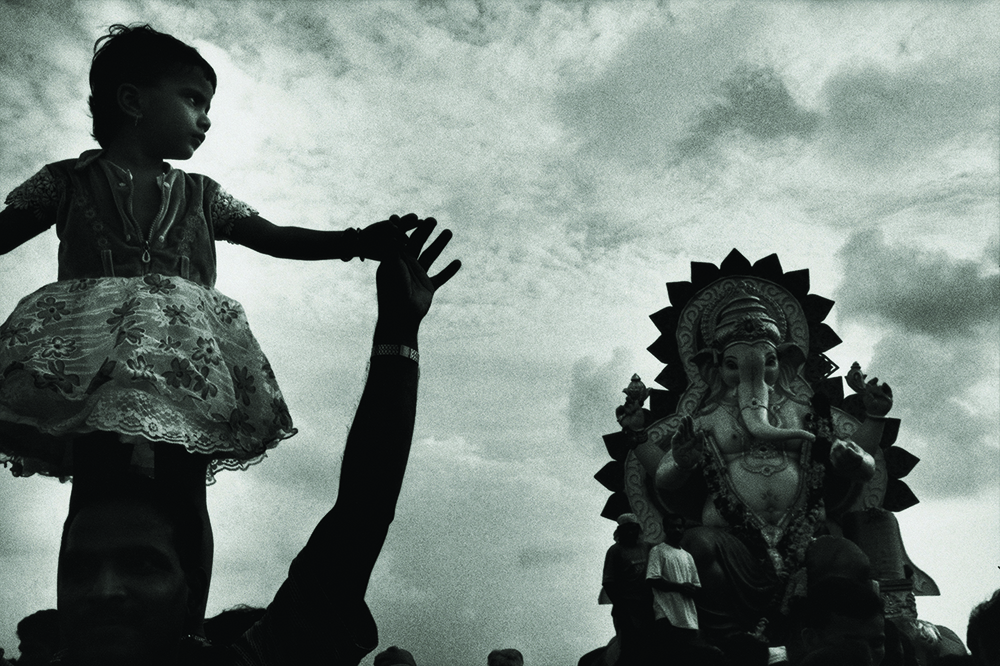
Ketaki Sheth, Girl at Ganpati Immersion, Chowpatty, 2002, gelatin silver print, 36.8 x 55.9 cm (National Museum of Asian Art, Washington DC)
A photograph by artist Ketaki Sheth depicts a little girl, wearing a lacy floral dress and standing upon the shoulders of a man, perhaps her father, to get a better view of the surrounding crowd that carries a large sculptural image of the Hindu god Ganesha. Sheth captures a moment of stillness during an otherwise boisterous and energetic occasion: the artist brings us above the crowd and into the clouds that backlight the richly adorned body of the elephant-headed deity—remover of obstacles and son of Shiva and Parvati—on his way toward a body of water for ritual immersion during the annual festival of Ganesha Chaturthi.
Impermanence and belief
The practice of ritually submerging, and thereby destroying, sculptural images of Ganesha during Ganesha Chaturthi represents one of several religious and cultural acts in South Asia which complicate ideas about the value and permanence of material objects. Makers involved in these practices produce objects and artistic depictions with the knowledge that the products of their creative labor are temporary and will be intentionally destroyed or deteriorate over time. In some cases these practices of ritual destruction resonate with ideas about the cyclical nature of time as described in concepts like samsara. In other cases the destruction of an object is symbolic of the removal of evil and the restoration of good in the universe. In still other cases, we find beautifully wrought material objects whose impermanence is embedded in their form and function, much like disposable paper plates.
These examples challenge us to push against the preciousness of objects—an approach that we encounter so often in the study of art—and to rethink the way we value the permanence / impermanence of material things. This call to rethink our valuation of objects is also critical to the decolonizing of the discipline of art history; privileging objects of durable and precious materials over ephemeral works of art (such as things made from unfired clay, paper, or cotton fiber) is in many ways a legacy of British colonial rule on the subcontinent that sought to promote a Eurocentric view and valuation of objects and artistic practices.[1]
For the Ganesha images created in celebration of Ganesha Chaturthi, their destruction is a joyous celebration. Occurring in August or September of each year according to the Hindu lunar calendar, the ritual immersion of Ganesha marks the deity’s birth and symbolic return to the earth. [2] According to legend, Ganesha was created from clay by the goddess Parvati and was given an elephant’s head after his father, the god Shiva, inadvertently beheaded him. Ganesha Chaturthi celebrates the moment when the deity received his elephant head, and his ritual immersion in water each year following ten days of rites is a significant event that bestows blessings on devotees.
Immersion as purification
It is not surprising that worshippers laboriously carry sacred sculptural images or murtis of Ganesha to local bodies of water for ritual immersion. Water is a symbolic purifier in South Asia and used in numerous religious and cultural practices connected with worshipping Hindu gods and goddesses as well as honoring holy figures, saints, and sacred architecture in Buddhist, Christian, Jain, Muslim, and Sikh beliefs. For the Hindu devotees participating in ritual immersion festivals like Ganesha Chaturthi, the water itself is sacred and ultimately connected to the holiest river in India, the Ganga.[3]
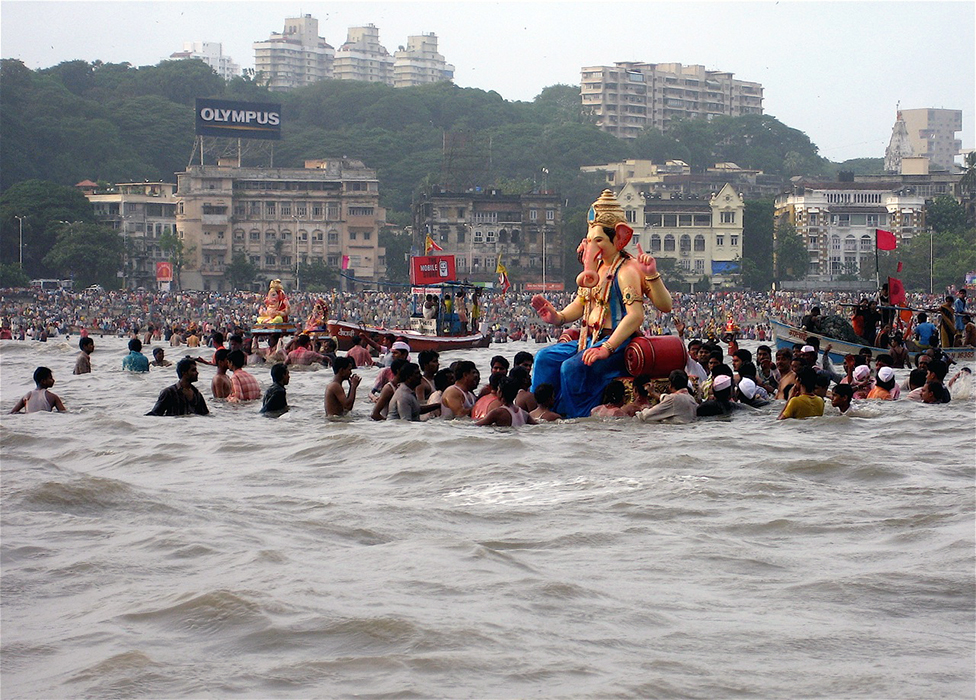
Ganesh Visarjan at Girgaum Chowpatty, c. 2007 (photo: Chris: CC BY 2.0)
Historically, artists made disposable or perishable murtis of the god from unfired clay or low-fired terracotta decorated with natural pigments. [4] These images would slowly dissolve in water and eventually be reincorporated into the ecosystem. However, over the last several decades increasingly larger Ganesha images made from synthetic paints, gypsum plaster (plaster of Paris), and plastic ornaments have become popular, and the heavy metals and toxins associated with these raw materials have leached into India’s waterways, creating dangerous amounts of pollution. [5] Recently, the Government of India’s Central Pollution Control Board established rules requiring that devotees use Ganesha murtis made from biodegradable materials (like terracotta) and have encouraged that ritual immersion practices occur in specially-designated water tanks.
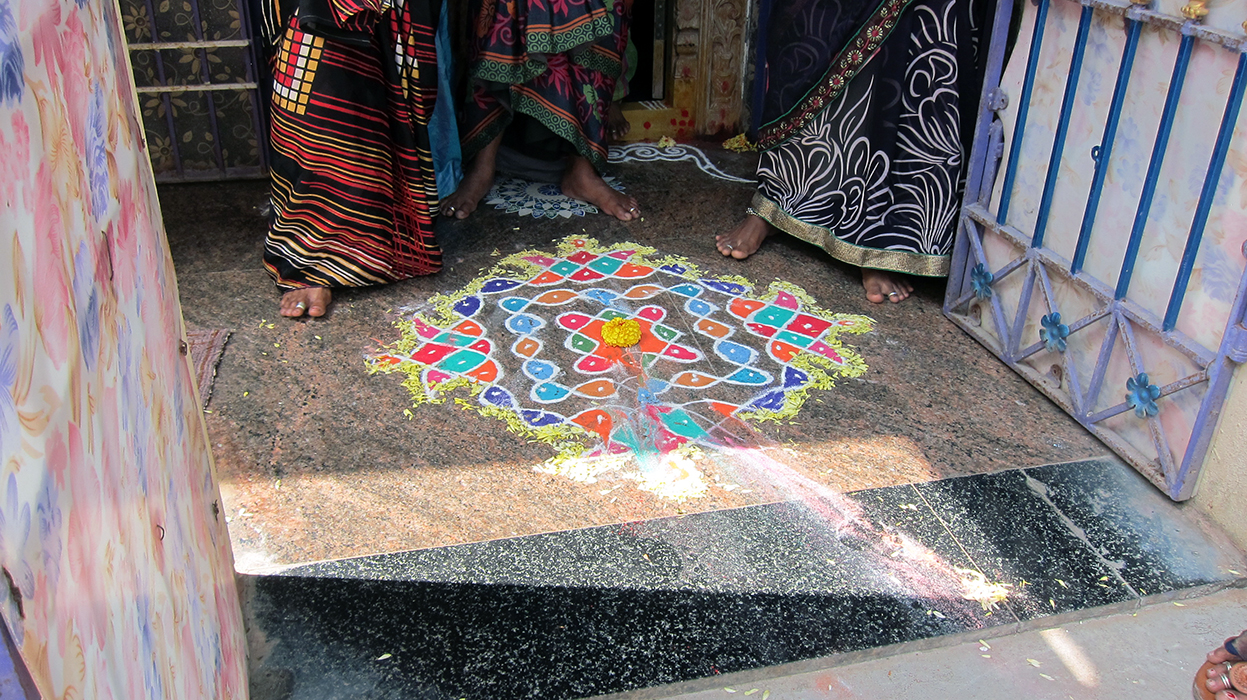
Alpana patterns created for the festival of Sankranti. Tirupathi, Andhra Pradesh, India, 2020 (photo: Dr. Cristin McKnight Sethi, CC BY-NC-SA 2.0)
In addition to annual events like Ganesha Chaturthi, the making of temporary, perishable objects and artistic depictions appear on a daily basis in many parts of India through the creation of decorative floor paintings known by various names including alpana, kollam, and rangoli. [6] Typically made by female members of a household or community using rice flour, chalk, powdered pigments, or flowers, the symmetrical forms of these temporary paintings symbolize divine power. They are intended to sanctify a space, and have ancient origins in goddess worship. [7] For special festivals some women create particularly elaborate floor paintings that last for several months or even up to a year. There are many, however, who treat this practice as a daily ritual with the intention that the painting will be swept clean and remade each morning—the epitome of intangible cultural heritage. [8]

Left: Rangoli in chalk (photo: ramya_aiyappan, CC BY-NC 2.0) Right: Rangoli in chalk and flowers (photo: McKay Savage, CC BY 2.0)
Destroying the demon king
A particularly dramatic example of the ritual destruction of objects occurs with sculptural effigies of the demon king Ravana and his demon armies which are burned and physically torn apart during multi-day performances of the Ramacharitamanas, the Hindi version of the story of Rama which is especially popular throughout North India and famously performed in the city of Ramnagar. [9] This performance, known locally as Ramlila, narrates the story of Rama, an earthly form or avatar of the Hindu god Vishnu, who is the beloved king of the city of Ayodhya and husband to Sita, an avatar of the goddess Lakshmi. The Ramacharitamanas, similar to the Sanskrit Ramayana, describes the adventures of Rama, his brother Lakshmana, and Sita during their fourteen-year exile from Ayodhya. The story culminates in a series of battles between Rama and the powerful demon king, Ravana, who has abducted Sita and held her captive at his palace in Lanka.
In the final days of the Ramlila performance, sculptural depictions of Ravana and other demons made from bamboo and paper are set ablaze to symbolize their mythological destruction. The most dramatic moment in the Ramlila performance occurs on Dussehra, an important Hindu festival celebrated throughout India, when participants destroy sculptural depictions of Ravana, sometimes 75-feet tall and filled with firecrackers, to mark Rama’s victory over the demon king and the ultimate victory of good over evil.
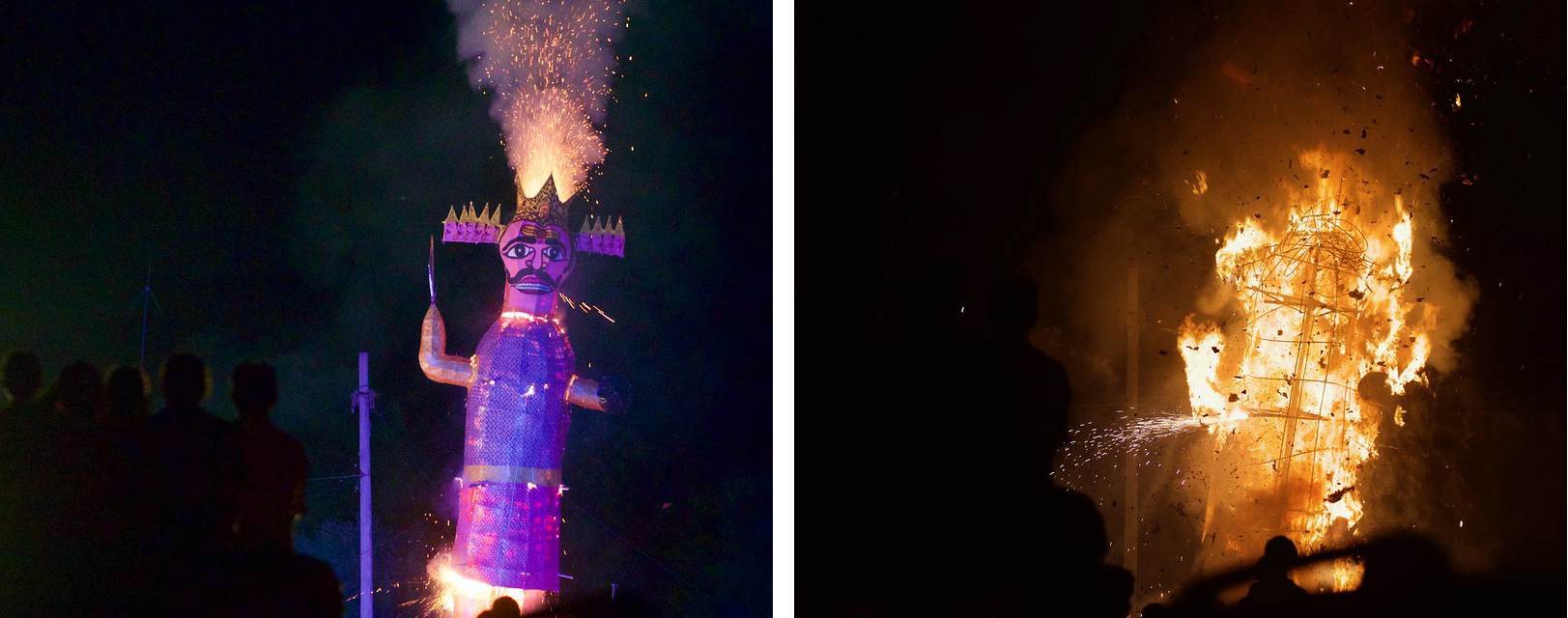
Destruction of a Ravana sculpture during Dusshera at Ranthambore, Sawai Madhopur. Rajasthan, Oct 2019 (photo: Kandukuru Nagarjun, CC BY 2.0)
In other parts of India, Dusshera is celebrated as a way to mark the goddess Durga’s victory over the buffalo demon Mahishasura, understood by devotees as a mythological act that restores dharma to the universe. Worshippers celebrate Dusshera by creating elaborate temporary altars or pandals for Durga, many of which are then submerged in water on Dusshera, marking the culmination of nine nights of celebration known as Navratri. The pandals made for the worship or puja of Durga are most famously created in Bengal where families, neighborhoods, community organizations, and businesses commission elaborate pandals that incorporate depictions of iconic architecture and motifs from popular culture. [10]
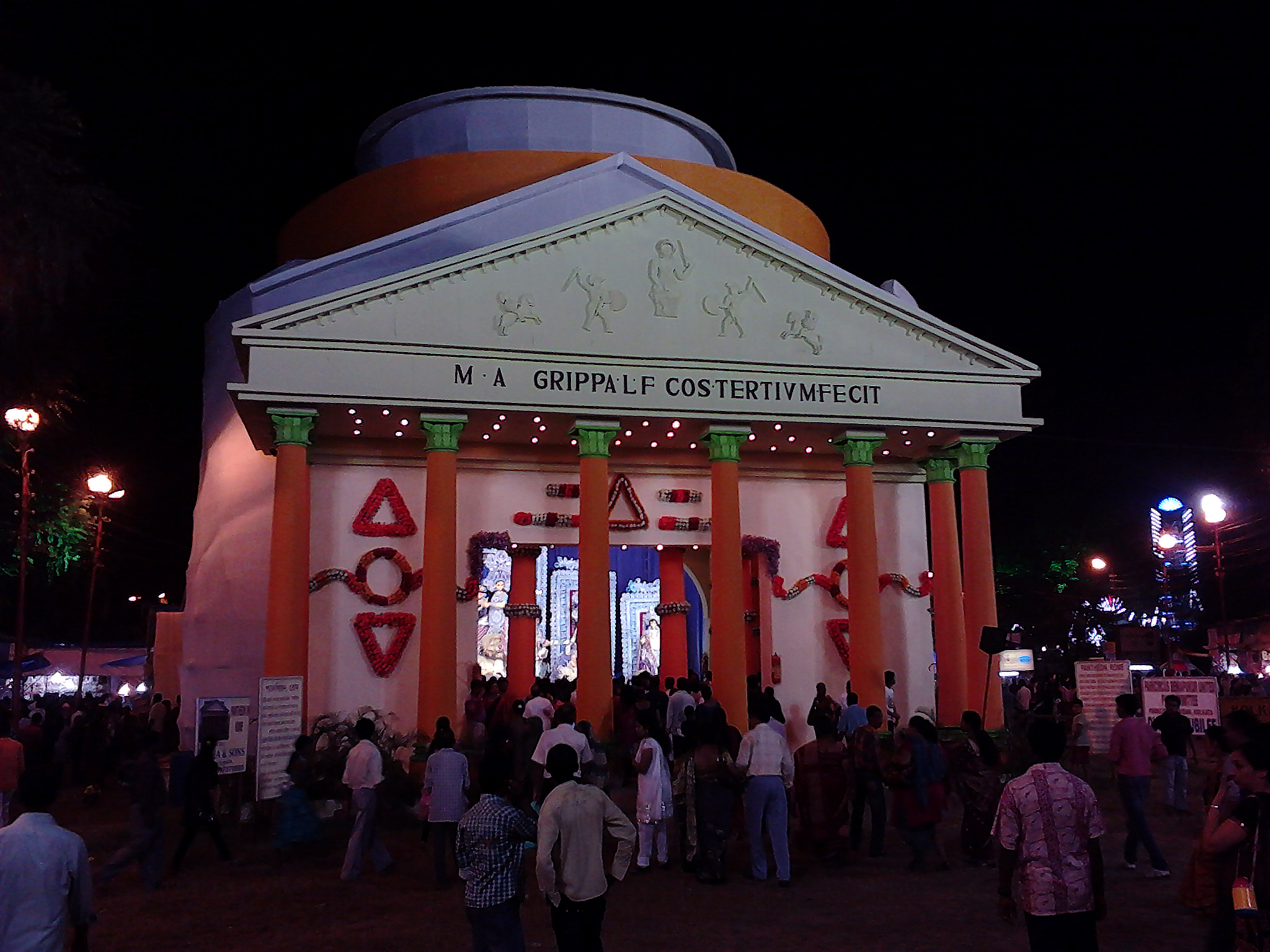
Durga puja pandal modeled after the Pantheon (photo: Biswarup Ganguly, CC BY 3.0)

Raghu Rai, INDIA, Calcutta, Finally, Durga is brought to the Ganges for immersion. Magnum Photos PAR156220 © Raghu Rai / Magnum Photos
A photograph by artist Raghu Rai depicts the ritual immersion of Durga during a Dusshera celebration in Kolkata. In Rai’s image we see a larger-than-life murti of Durga being carried with bamboo poles to the Ganga by several human figures—a scene that parallels depictions of Ganesha Chaturthi. These human devotees work together to hoist the goddess into the river. We see Durga’s many arms clearly holding the weapons she uses to vanquish Mahishasura and her lion mount or vahana with its mouth agape seated nearby. A nineteenth-century painting of a similar moment suggests earlier practices of this form of ritual immersion. While the focus in the painting is on the elaborately adorned murti of Durga and the human devotees who carry her pandal in procession, in the foreground of the scene appears loose brushstrokes that hint at water, perhaps a subtle indication of the immersion to come.
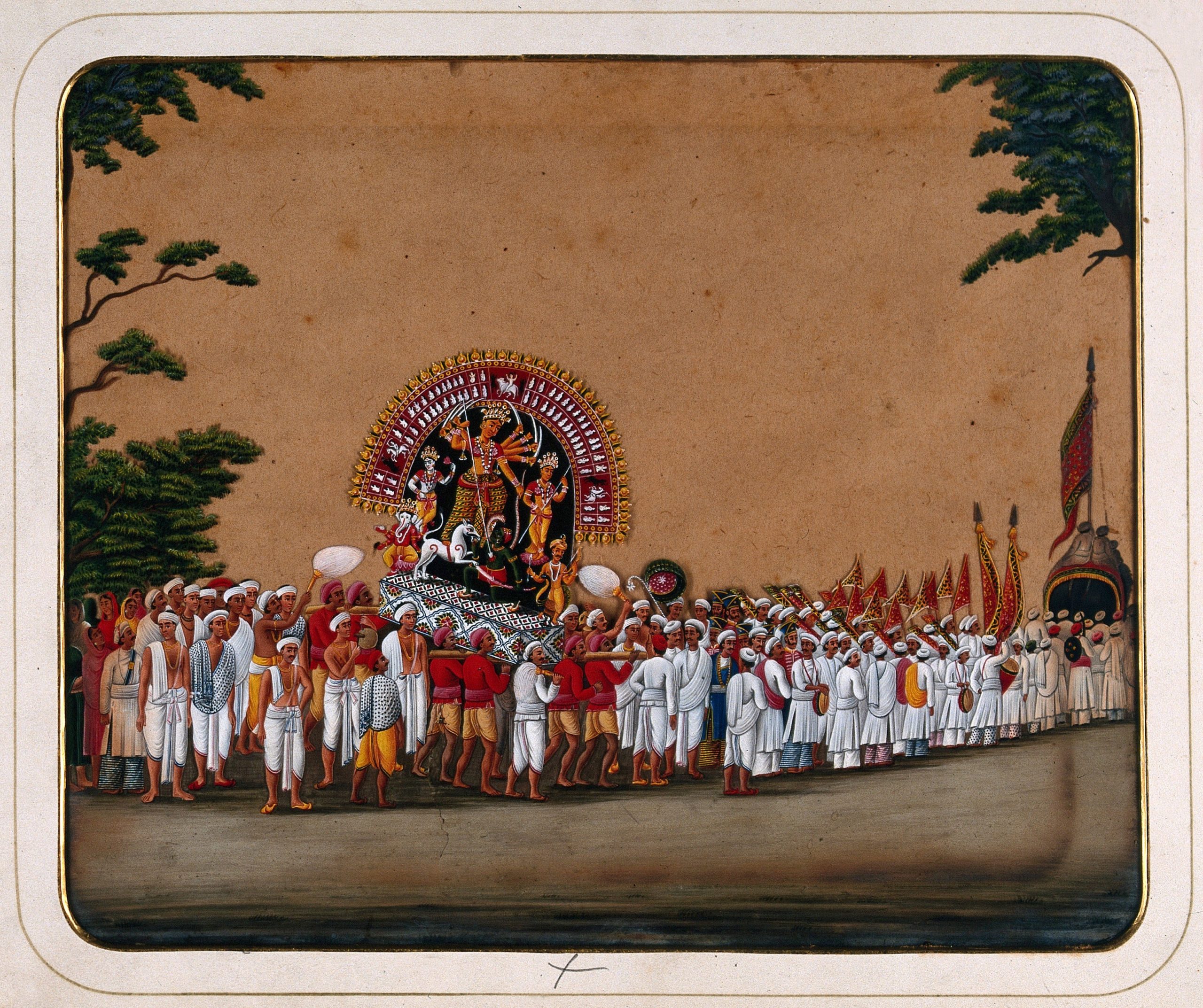
Durga Puja: a procession carrying an idol of Durga to honor her victory over evil, 19th century, in A Collection of Indian costumes, types and occupations, gouache on mica (Wellcome Library, CC BY 4.0)
Flowers and cups

Adornment (alankara) of Ganesha murti in a home shrine, Bangalore, 2004 (photo: Dr. Cristin McKnight Sethi, CC BY-NC-SA 2.0)
The practice of ritually submerging or destroying images is not limited to depictions of gods, goddesses, or demons, but even applies to the floral garlands that adorn many sacred images. The practice of alankara or adorning a murti includes dressing the deity in strands of marigolds, roses, and jasmine flowers. Floral offerings are also used in worship at other religious sites in India including Sufi shrines, Sikh temples, and Christian churches. These flowers are most often tossed into water after their use in religious rites. Once blessed by the divine these floral offerings need to be disposed of in the holiest way possible, either scattered in a sacred river like the Ganga or immersed in a local body of water.
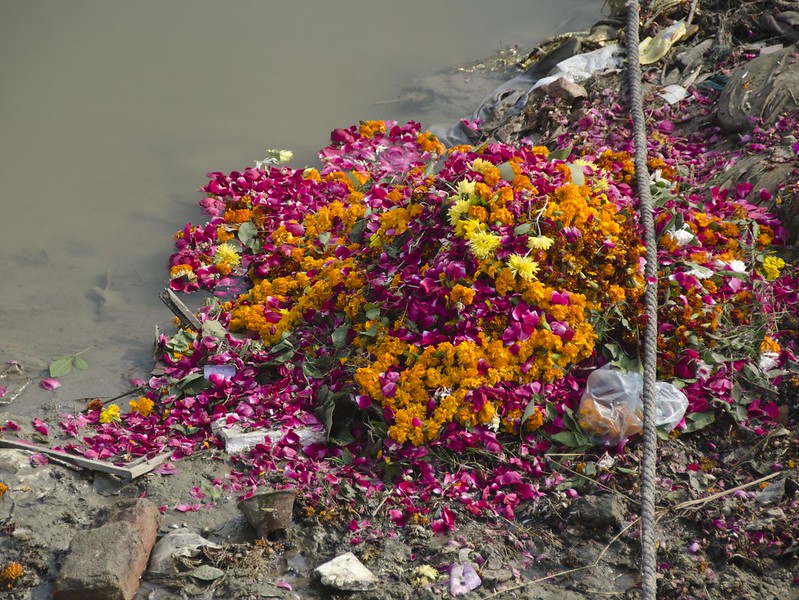
Discarded flowers, Varanasi (Banaras), India, 2011 (photo: Eric Parker, CC BY-NC 2.0)
With increased scrutiny over environmental repercussions of such ritual practices, entrepreneurs and designers have begun to collect these discarded flowers and upcycle them into new products. Textile artist Rupa Trivedi and her team at Adiv Pure Nature have created a way to reuse flowers discarded by the Siddhivinayak Hindu temple and the Haji Ali Sufi shrine in Mumbai to create contact-dyed garments and home textiles. In these textiles the temporary floral offerings are made more permanent by imprinting their natural pigments onto cotton and silk fibers. By using water throughout the mordanting and dyeing process, Trivedi maintains the sacred connection to water that is so pivotal to ritual immersion. While Trivedi’s textiles give new life to floral offerings that would otherwise decompose into the earth, it is striking that textiles as a medium epitomize intangibility and impermanence: textiles are objects that break apart through wear and tear, fade under excessive exposure to sunlight, and deteriorate when subjected to bacteria, fungus, or invasive insects.

Detail of fabric by Adiv Pure Nature dyed with upcycled marigold flowers
Perhaps the most pervasive example of the regular destruction of impermanent, temporary objects occurs through the culture of food. Ceramic artists all over South Asia produce small vessels from low-fired terracotta to be used for drinking spiced tea known as masala chai or yoghurt beverages known as lassis which are sold at roadside stands and eateries. While many vendors of chai and lassi have taken to glass, paper, plastic, and styrofoam substitutes, there are still some who prefer to use traditional clay cups.[11] The potters who make these hand-thrown vessels do so with the knowledge that these objects will have short lives: they will be thrown to the ground or crushed underfoot after the chai or lassi has been drunk.
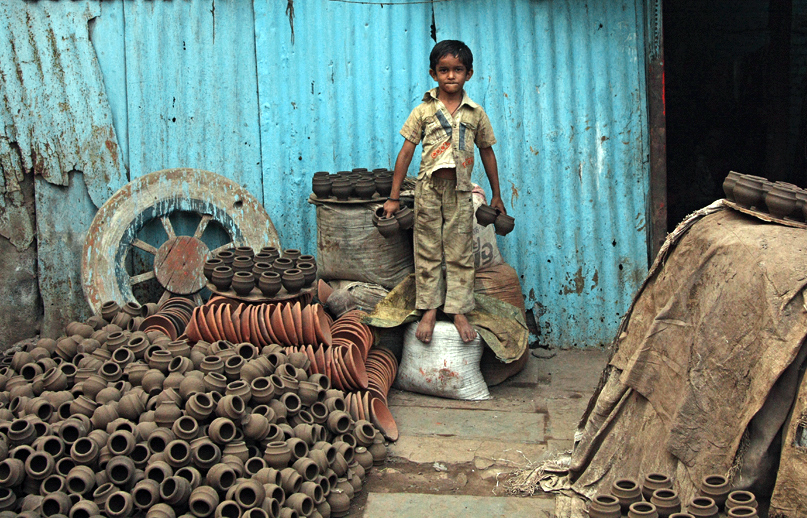
A boy stands in a potter’s yard, holding traditional clay cups (photo: Meena Kadri, CC BY-NC-ND 2.0)
Much of the value of these objects lies in their impermanence and the easy way they return to the earth. While some chai or lassi cups may enter into museum collections—quintessential repositories of permanent objects—their most potent cultural value and circulation is in their temporary use and ultimate demise. As such these vessels remind us that not all tangible cultural heritage is in need of preservation, and sometimes a community requires, even celebrates, the destruction of cultural objects.
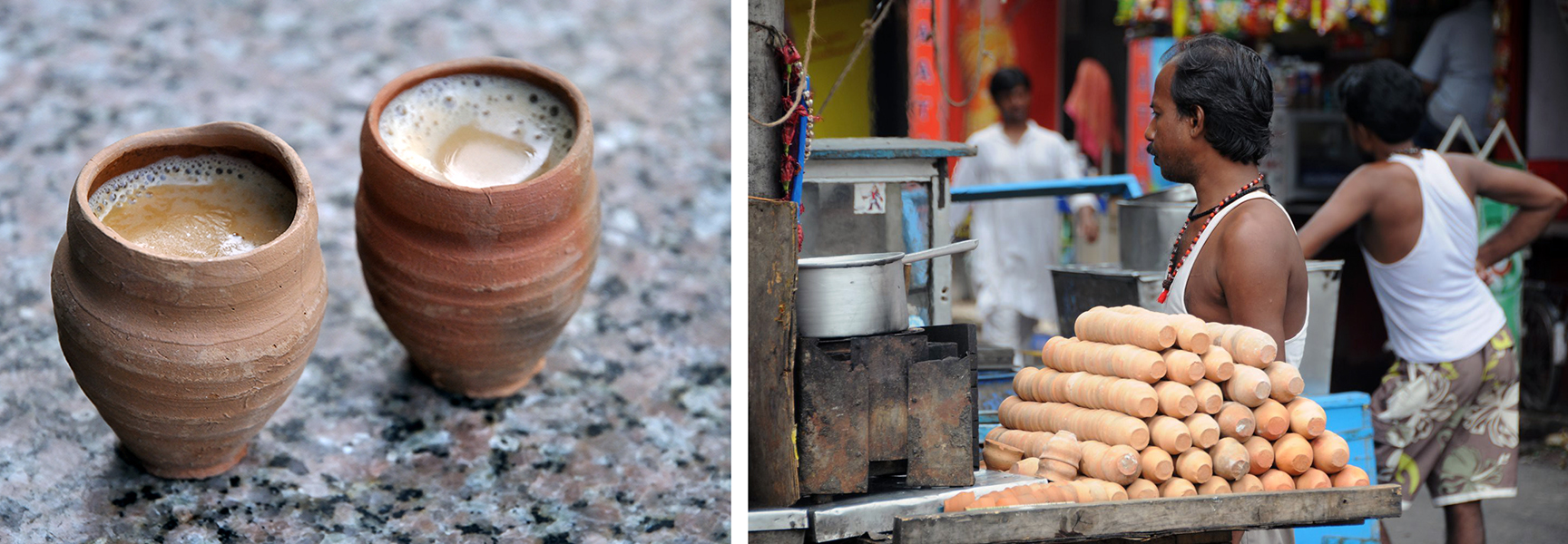
Left: Masala chai in terracotta cups (photo: Biswarup Ganguly, CC BY 3.0); Right: Chai vendor, Kolkata (photo: Nomad Tales, CC BY-SA 2.0)
Notes:
- For an expanded discussion of colonial valuation of “fine arts” vs. “craft” within the context of unfired clay sculpture see Susan Bean, “The Unfired Clay Sculpture of Bengal in the Artscape of Modern South Asia,” in Rebecca M. Brown and Deborah S. Hutton, eds., A Companion to Asian Art and Architecture (West Sussex: Wiley Blackwell, 2011), 604–628.
- Ganesha Chaturthi occurs every year on the day of Ananta Caturdasi in the month of Bhadrapada (according to the Chandramana calendar).
- For more on the sacred nature of the Ganga and its connection to other bodies of water in India, see Diana Eck, India: A Sacred Geography (New York: Random House, 2012), 131–188.
- Clay has been a material of ritual importance on the subcontinent for millennia. See Bean, “The Unfired Clay Sculpture of Bengal,” 609.
- For further discussion of the environmental implications of ritual immersion of synthetic Ganesha images see Dinesh C. Sharma, “Idol immersion poses water pollution threat” in Frontiers in Ecology and the Environment (October 2014, Vol. 12, No. 8): 431; and M. Vikram Reddy and A. Vijay Kumar, “Effects of Ganesh-idol immersion on some water quality parameters of Hussainsagar Lake” in Current Science, Vol. 81, No. 11 (10 December 2001): 1412–1413.
- Vijaya Nagarajan, Feeding a Thousand Souls: Women, Ritual, and Ecology in India – An Exploration of the Kolam (New York: Oxford University Press, 2019). There are also comparable ornamental patterns made on the walls of homes. See for example, Asimakrishna Dasa, Evening Blossoms: The Temple Tradition of Sanjhi in Vrndavana (New Delhi: Indira Gandhi National Centre for the Arts, 1996).
- See for example, Stella Kramrisch, “The Art Ritual of Women,” in Unknown India (Philadelphia: Philadelphia Museum of Art, 1968); and Pupul Jayakar, The Earthen Drum: An Introduction to the Ritual Arts of Rural India (New Delhi: National Museum, 1980).
- Tibetan Buddhist monks are famous for creating similar temporary paintings in the form of sand mandalas. For example, see monks creating a mandala at the Rubin Museum.
- For more on the Ramlila of Ramnagar, see Richard Schechner and Linda Hess, “The Ramlila of Ramnagar” in The Drama Review: TDR, September 1977, Vol. 21, No. 3, Annual Performance Issue (September 1977): 51–82; and “Ramnagar Ramlila: All about the 200-yr-old cultural extravaganza.”
- For more on Durga Puja pandals and their makers see Bean, “The Unfired Clay Sculpture of Bengal in the Artscape of Modern South Asia,” 604–628; Tapati Guha-Thakurta, “From Spectacle to ‘Art’” in ArtIndia Vol 9, Issue 3 (Quarter 3, 2004): 34–56; Krishna Dutta, Image-Makers of Kumortuli and the Durga Puja Festival. New Delhi: Niyogi Books, 2016; and Geir Heirestad, “The Durga Puja Business,” in Caste, Entrepreneurship and the Illusions of Tradition: Branding the Potters of Kolkata (Anthem Press, 2017), 1–6.
- The Government of India is committed to making India free of single-use plastics and recently reintroduced the use of terracotta chai cups at over 7000 railway stations around the country: https://www.theguardian.com/
global-development/2020/dec/ 03/all-change-indias-railways- bring-back-tea-in-clay-cups- in-bid-to-banish-plastics.”

